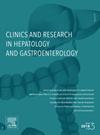疑似阑尾炎患者直肠微生物组的前瞻性队列研究。
IF 2.4
4区 医学
Q2 GASTROENTEROLOGY & HEPATOLOGY
Clinics and research in hepatology and gastroenterology
Pub Date : 2025-09-01
DOI:10.1016/j.clinre.2025.102675
引用次数: 0
摘要
目的:阑尾炎诊断困难。已经提出了一种感染源,因此来自微生物组的信号可能是一种潜在的诊断措施。目的是评估直肠微生物组在疑似阑尾炎患者中的诊断潜力。方法:在一项前瞻性、观察性队列研究中,我们纳入了丹麦疑似阑尾炎接受阑尾切除术的成年患者。首先根据组织病理学结果将患者分为有阑尾炎患者和无阑尾炎患者,其次根据手术报告将患者分为无并发症和并发症阑尾炎患者。采用霰弹枪宏基因组学对直肠拭子进行分析。结果是α多样性、β多样性和细菌的差异丰度。结果:分析220例患者的直肠拭子:无阑尾炎49例,无并发症阑尾炎111例,合并阑尾炎60例。在所有组中,α和β的多样性都是相似的。细菌属和种的相对丰度在所有组中也相似。因此,三组患者具有相似的直肠微生物组。结论:怀疑阑尾炎的成年患者直肠微生物组相似,术前诊断阑尾炎和判断阑尾炎严重程度似乎都没有潜力。试验注册:NCT03349814 (clinicaltrials.gov)。本文章由计算机程序翻译,如有差异,请以英文原文为准。
A prospective cohort study of the rectal microbiome in patients with suspected appendicitis
Purpose
Diagnosing appendicitis is difficult. An infectious origin has been proposed, therefore signals from the microbiome could be a potential diagnostic measure. The aim was to evaluate the diagnostic potential of the rectal microbiome in patients with suspected appendicitis.
Methods
We included adult Danish patients with suspected appendicitis undergoing appendectomy in a prospective, observational cohort study. Patients were first grouped as patients with and without appendicitis according to histopathological findings, and second, as having uncomplicated or complicated appendicitis according to the surgical report. Rectal swabs were analysed with shotgun metagenomics. The outcomes were alpha diversity, beta diversity, and differential abundance of bacteria.
Results
Rectal swabs from 220 patients were analysed: 49 patients without appendicitis, 111 patients with uncomplicated and 60 patients with complicated appendicitis, respectively. Across all groups, both the alpha and beta diversity were similar. The relative abundance of bacterial genera and species was also similar across all groups. Thus, the three groups of patients had similar rectal microbiomes.
Conclusion
The rectal microbiome in adult patients with suspected appendicitis was similar and does not seem to have the potential to be used to diagnose neither appendicitis nor the severity of appendicitis preoperatively.
Trial registration
NCT03349814 (clinicaltrials.gov)
求助全文
通过发布文献求助,成功后即可免费获取论文全文。
去求助
来源期刊

Clinics and research in hepatology and gastroenterology
GASTROENTEROLOGY & HEPATOLOGY-
CiteScore
4.30
自引率
3.70%
发文量
198
审稿时长
42 days
期刊介绍:
Clinics and Research in Hepatology and Gastroenterology publishes high-quality original research papers in the field of hepatology and gastroenterology. The editors put the accent on rapid communication of new research and clinical developments and so called "hot topic" issues. Following a clear Editorial line, besides original articles and case reports, each issue features editorials, commentaries and reviews. The journal encourages research and discussion between all those involved in the specialty on an international level. All articles are peer reviewed by international experts, the articles in press are online and indexed in the international databases (Current Contents, Pubmed, Scopus, Science Direct).
Clinics and Research in Hepatology and Gastroenterology is a subscription journal (with optional open access), which allows you to publish your research without any cost to you (unless you proactively chose the open access option). Your article will be available to all researchers around the globe whose institution has a subscription to the journal.
 求助内容:
求助内容: 应助结果提醒方式:
应助结果提醒方式:


